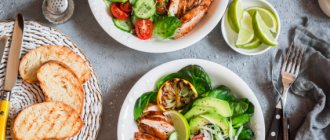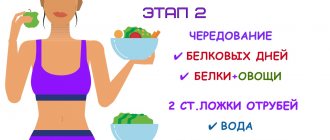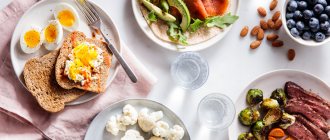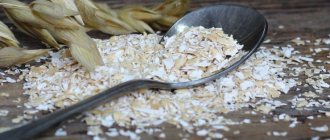Treatment of diseases of the gastrointestinal tract should be comprehensive. Special dietary nutrition, which was developed by professor-gastroenterologist Manuil Pevzner in the twentieth century, takes first place in the treatment of these diseases. Each of his 15 diets is still successfully used today and is designed to help patients recover faster from various pathologies. Such diets are called “tables” and have their own serial numbers.
For acute intestinal diseases and digestive disorders, the fourth diet is prescribed. This nutrition system is divided into several options, each of which corresponds to a specific patient’s condition. Let's take a closer look at each point: how to observe them correctly, what you can eat, and what tasty things to cook if you can only use jelly.
Treatment table No. 4
Diet No. 4 is prescribed for intestinal diseases accompanied by frequent and loose stools, acute pain and flatulence. In addition, it is used for colitis and exacerbations of chronic gastrointestinal diseases (ulcers, gastritis, dysphagia). In such conditions, the patient develops dyspepsia, which is characterized by stool upset, abdominal pain, nausea, and cramps. Therefore, therapeutic nutrition should fully provide the patient during this period not only with nutrients, but also help reduce inflammatory reactions from the gastrointestinal mucosa.
Content:
- Treatment table No. 4
- Menu for table No. 4
- Treatment table 4a
- Treatment table 4b
- Treatment table 4v
The diet is also aimed at restoring microflora, relaxing muscles, and improving intestinal motility. The goal of a therapeutic diet is to ensure maximum relief of the digestive process, and then restoration of the gastrointestinal tract. For this, Manuil Pevzner created a therapeutic diet, which includes special foods and dishes, as well as food processing methods (sparing). Table No. 4 provides for a special menu with strict control of the food consumed. But, first of all, in such a diet it is important to take into account methods of sparing the gastrointestinal mucosa. We'll talk about them below.
Mechanical – grinding the dish, food is consumed in a grated, liquid form. This is necessary in order to restore the mucous membrane of the digestive system and speed up recovery. Eating food in pureed, mushy and liquid form does not irritate the walls of organs and the lining of the tract. In other words, the food should be similar to baby food.
Chemical. This means eating food that does not increase the secretion of gastric juice, bile and enzymes, and does not cause rotting or fermentation processes in the intestines. To better understand the chemical composition, below we will consider in detail the list of products. Table 4 is considered incomplete, since the amount of carbohydrates and fats must be reduced. The basis of the diet should be proteins. The amount of salt and sugar should be minimal.
Thermal sparing – involves maintaining a certain temperature of the served dish. Too cold or very hot food (and drink) irritates the mucous membrane. Patients who follow table number 4 are only given warm drinks and dishes. The optimal temperature is from 15 degrees to 45. Everything that is consumed by the patient should not irritate the oral cavity in any way. Food should be pleasant, soft and easy to swallow. The same rule applies to the composition of food: spicy, hot, sour, salty and pickled foods are excluded from the diet.
Basic rules of the diet: you need to eat in small portions and often, 4-6 times a day, it is strictly forbidden to go hungry and overeat. Fried and baked foods with a crust are completely excluded from heat treatment. Food can be boiled, steamed, baked in foil, or stewed. These rules apply to all diet options: No. 4, 4a, 4b, 4c.
When compiling a treatment menu, the following are excluded:
- rich broths, first courses with pasta and whole grain cereals;
- flour products (only white bread crackers are allowed);
- fatty meat, fish;
- dairy products;
- eggs in any form;
- all legumes;
- vegetables (only for decoctions);
- fresh and dried berries and fruits (small quantities of such products in jelly are allowed);
- sparkling water, coffee, strong tea;
- sauces and spices, marinades and canned food.
You can add to the menu:
- soups from lean fish, meat and vegetables;
- wheat crackers (100-200 g per day);
- steamed and baked rabbit meat, chicken fillet, turkey, lean veal and beef;
- semolina, oatmeal, rice and buckwheat (we are talking about pureed cereals);
- cocoa without milk, herbal infusions;
- butter (5 g per meal).
For a visual example, consider a sample menu and dietary recipes. You can create your own menu for the week by choosing from the lists provided.
Diet number 4 for colitis
The therapeutic nutrition system table number four is prescribed for enterocolitis and chronic colitis in the acute stage, for acute gastroenterocolitis in the initial stage of the disease, for typhoid fever and dysentery. While following this diet, carbohydrates and fats are limited, and protein intake remains at the same level. The amount of salt in the diet is reduced, and the intake of chemical and mechanical irritants to the receptor apparatus of the gastrointestinal tract and mucous membrane is sharply reduced.
Avoid dishes and products that enhance the processes of putrefaction and fermentation in the intestines, as well as strong stimulants of bile secretion and substances that irritate the liver. The goal of diet table number four is to reduce inflammation, normalize the functions of the intestines and other digestive organs, and ensure complete absorption of nutrients. All dishes on this diet are steamed or boiled and mashed. There are 5-6 meals per day (fractional meals).
Menu for table No. 4
Menu for table No. 4
| Eating | List of dishes |
| For breakfast | Liquid semolina porridge, pureed oatmeal, low-fat cottage cheese, grated apples, cocoa, baked pears or apples, green tea |
| For lunches | Broth with semolina, vegetable broth and pureed buckwheat, rice soup with meatballs, weak fish broth with herbs and rice, wheat crackers |
| For dinners | Mashed porridges from permitted grains, steamed cutlets, stewed fish and meatballs, semolina soufflé, meat puddings, baked fish (without skin) |
| For snacks | Homemade jelly, jellies, rosehip infusions, wheat crackers, berry and fruit infusions (without sugar), cocoa in water, baked pears and apples |
It is quite difficult to follow such a strict diet. The duration of the treatment course is determined by the doctor. As a rule, this is a short-term diet, so you will have to endure a little. After you feel better, the doctor prescribes a different diet. Let's look at some recipes that will help diversify your daily menu.
Rice cocoa recipe
To prepare you will need:
- 100 g rice;
- 1.5 liters of water;
- 50 g cocoa;
- a little sugar.
The washed rice should be completely boiled over low heat. Strain the resulting mass through cheesecloth. Grind cocoa with sugar until smooth. Pour cocoa into the rice broth and strain everything again. Serve the resulting drink warm. The recipe is suitable for all diet options and table No. 10.
Meat quenelles recipe
To prepare you will need:
- 100 g cottage cheese;
- 200 g beef (fillet without tendons and fascia);
- 1 chicken egg;
- 10 g butter.
The beef must be cut and minced twice. Rub the cottage cheese thoroughly through cheesecloth. Mix the minced meat and cottage cheese, add a little salt, beat in the egg, then add soft butter. Mix everything well and form quenelles. Steam for 20 minutes. The recipe is suitable for tables: 4, 4a, 4b, 4c.
Treatment table 4a
Diet 4a is prescribed for any intestinal dysfunction that is caused by increased gas formation, as well as for chronic colitis. To restore the digestive process, foods that cause oxidation are completely excluded from the treatment menu. This is the entire list of dishes and components for the 4th table. You should also limit the amount of chicken, fresh dairy products, completely eliminate raw vegetables and fruits, coffee, any sweets, and carbonated drinks.
The diet consists mainly of protein foods. Fats and carbohydrates are present in the diet in minimal quantities. As a rule, such a diet is prescribed for the first time of treatment, then the patient is transferred to another diet according to Pevzner. You should also strictly observe all three types of sparing. The rules for the diet are the same as in No. 4.
You can eat pureed, soft food warm. For flour products, soft noodles and white crackers are allowed. From dairy products you can eat low-fat and calcined cottage cheese, yogurt and kefir at night. Whole grain cereals are completely excluded, only crushed ones are allowed, from which it is easy to prepare mucous decoctions. Soups can be prepared using second fish and meat broths. It is better to draw up a complete list of products for colitis with a gastroenterologist, based on the patient’s condition.
Sample menu for the day for table 4a
For breakfast: sour cream cottage cheese, soft-boiled egg, tea.
For lunch: cream of meat soup, chopped vermicelli.
Afternoon snack: baked ripe apples.
For dinner: steamed meatballs from lean fish (hake, pike perch, cod).
A couple of hours before bedtime: 250 ml of kefir.
Calcined cottage cheese recipe
To prepare dietary cottage cheese, you will need calcium chloride or calcium lactic acid powder. For 0.5 liters of milk you need one and a half spoons of solution or 3 g of powder. The milk needs to be heated over low heat to about 400, without removing from the heat, add the powder or solution. As soon as the curd appears, it needs to be placed on cheesecloth to drain.
It is better to choose homemade milk, since store-bought cottage cheese may not produce at all, or it may produce too little. This cottage cheese is suitable for all four diet options.
Authorized Products
- Table No. 4A provides for the use of dried wheat bread or crackers. You can eat 100-150 g of crackers (or gluten-free) per day. You can eat soy flour products.
- The basis of the diet is protein products. It is recommended to consume lean varieties of beef, chicken, turkey, and veal. The meat is additionally degreased and the skin of the poultry is removed. The meat is used to prepare steamed cutlets, pate (boiled), soufflé or meatballs. These products can be boiled. When preparing cutlets, add a little boiled rice to the minced meat.
- Low-fat fish (pollock, blue whiting, hake, pike perch) are prepared in pieces or in the form of quenelles, cutlets and meatballs.
- 1-2 eggs per day are allowed, which are cooked soft-boiled or steamed omelet.
- Soups are prepared in low-fat secondary fish or meat broth, adding a small amount of cereals, a minimum of vegetables, pureed meat, meatballs or egg flakes.
- Puree porridge made from buckwheat and oatmeal. They are cooked in water or low-fat broth. Butter is added in an amount of 5 g per serving, and vegetable oil is excluded.
- You can eat unleavened (non-acidic) cottage cheese, which is better pureed; you can also make casseroles from it.
- Vegetables (pumpkin, zucchini, carrots) are eaten only as a pureed addition to soups. If there is no diarrhea, it can be stewed.
- Mashed raw apples, applesauce, blueberry, dogwood, quince, bird cherry, and pear jelly are allowed. If well tolerated, you can drink diluted fresh juices from berries. Grape and plum juice should be excluded.
- Herbal teas, rosehip decoction, infusion of bird cherry, blueberry, dried dogwood, green and black tea, still water are allowed.
Table of permitted products
| Proteins, g | Fats, g | Carbohydrates, g | Calories, kcal | |
| quince | 0,6 | 0,5 | 9,8 | 40 |
| baked sweet and sour apples | 0,5 | 0,5 | 12,3 | 59 |
| dried pears | 2,3 | 0,6 | 62,6 | 249 |
| buckwheat (kernel) | 12,6 | 3,3 | 62,1 | 313 |
| oat groats | 12,3 | 6,1 | 59,5 | 342 |
| cereals | 11,9 | 7,2 | 69,3 | 366 |
| white bread crackers | 11,2 | 1,4 | 72,2 | 331 |
| kefir 1% | 2,8 | 1,0 | 4,0 | 40 |
| curdled milk 1% | 3,0 | 1,0 | 4,1 | 40 |
| acidophilus | 2,8 | 3,2 | 3,8 | 57 |
| cottage cheese 0.6% (low fat) | 18,0 | 0,6 | 1,8 | 88 |
| boiled beef | 25,8 | 16,8 | 0,0 | 254 |
| boiled veal | 30,7 | 0,9 | 0,0 | 131 |
| rabbit | 21,0 | 8,0 | 0,0 | 156 |
| boiled chicken | 25,2 | 7,4 | 0,0 | 170 |
| turkey | 19,2 | 0,7 | 0,0 | 84 |
| butter | 0,5 | 82,5 | 0,8 | 748 |
| mineral water | 0,0 | 0,0 | 0,0 | — |
| green tea | 0,0 | 0,0 | 0,0 | — |
| black tea | 20,0 | 5,1 | 6,9 | 152 |
| * data is per 100 g of product | ||||
Treatment table 4b
If intestinal diseases are accompanied by disturbances in the functioning of the pancreas, liver, or stomach, a therapeutic diet 4b is prescribed. It is mainly used for mild inflammatory phenomena of the intestinal mucosa. Compared to previous options, this diet is more balanced.
The list of prohibited products remains almost the same, but less severe. Allowed are bread of the first and highest grade, soups with well-cooked cereals (except millet, barley and pearl barley), boiled porridge, mild cheese, boiled sausage. You can add a little sour cream, cream and milk to your dishes. There should be no more than 10 g of butter per day. Natural desserts are allowed: meringues, jelly, marmalade, marshmallows. Some vegetables are also allowed: potatoes, cauliflower, carrots. Otherwise, the patient will have to adhere to the same framework as in diet 4. You need to eat in small portions, the food should be warm and soft.
The menu for the week can be compiled from a sample list.
For breakfast:
- steam omelette of 2 eggs with herbs, fruit jelly;
- liquid semolina porridge with sweet jam;
- sandwich made of toasted bread and grated cheese, baked apple;
- oatmeal with water, grated apple.
For lunch:
- fish broth with potatoes and boiled rice;
- weak beef soup with herbs and sour cream, mashed potatoes, steamed cutlets;
- soup with barley and grated carrots, buckwheat porridge and meatballs;
- vegetable broth with breadcrumbs and sour cream, boiled veal.
Snacks:
- apple jelly, tea;
- dogwood or currant jelly;
- cocoa in water with breadcrumbs or dry cookies (100 g);
- baked pears, homemade compote;
- calcined cottage cheese.
For dinners:
- pike perch in foil, steamed cauliflower;
- boiled beef puree, dried bread, compote;
- boiled tongue, mashed boiled carrots;
- fish balls in sour cream, boiled rice;
- soft buckwheat porridge, steamed rabbit cutlets.
You should try to consume at least 2500 kcal per day; nutrition should be balanced and nutritious. That is, you need to eat enough, not starve, your diet should include porridge, soups, meat, and boiled pureed vegetables. They adhere to this nutrition system for 2-4 weeks, after which they are prescribed 4B or another diet. The recipes for rice cocoa and meat quenelles discussed above are also suitable for this table.











